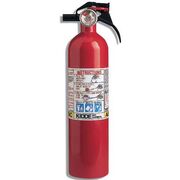
A fire extinguisher
About[]
A fire extinguisher, flame extinguisher, or simply an extinguisher, is an active fire protection device used to extinguish or control small fires, often in emergency situations. It is not intended for use on an out-of-control fire, such as one which has reached the ceiling, endangers the user (i.e., no escape route, smoke, explosion hazard, etc.), or otherwise requires the expertise of a fire department. Typically, a fire extinguisher consists of a hand-held cylindrical pressure vessel containing an agent which can be discharged to extinguish a fire. These devices should be mounted in readily accessible locations and employees must be periodically instructed in the use of fire extinguishers and fire protection procedures (i.e.PASS).
In the United States, fire extinguishers in all buildings other than houses are generally required to be serviced and inspected by a Fire Protection service company at least annually. Some jurisdictions require more frequent service for fire extinguishers. The servicer, person who inspects the device, places a tag on the extinguisher to indicate the type of service performed (annual inspection, recharge, new fire extinguisher).
There are two main types of fire extinguishers: stored pressure and cartridge-operated. In stored pressure units, the expellant is stored in the same chamber as the firefighting agent itself. Depending on the agent used, different propellants are used. With dry chemical extinguishers, nitrogen is typically used; water and foam extinguishers typically use air. Stored pressure fire extinguishers are the most common type. Cartridge-operated extinguishers contain the expellant gas in a separate cartridge that is punctured prior to discharge, exposing the propellant to the extinguishing agent. This type is not as common, used primarily in areas such as industrial facilities, where they receive higher-than-average use. They have the advantage of simple and prompt recharge, allowing an operator to discharge the extinguisher, recharge it, and return to the fire in a reasonable amount of time. Unlike stored pressure types, these extinguishers use compressed carbon dioxide instead of nitrogen, although nitrogen cartridges are used on low temperature (-60 rated) models. Cartridge operated extinguishers are available in dry chemical and dry powder types in the U.S. and in water, wetting agent, foam, dry chemical (classes ABC and B.C.), and dry powder (class D) types in the rest of the world.
Classes[]
In the United States, classes are labeled according to letters such as A, B, C, and D, though fore extinuishers are typically red, except for class D extinguishers, which are usually yellow, and water, which are usually silver, or white if water mist. Extinguishers are marked with pictograms depicting the types of fires that the extinguisher is approved to fight. In the past, extinguishers were marked with colored geometric symbols, and some extinguishers still use both symbols. The types of fires and additional standards are described in NFPA 10: Standard for Portable Fire Extinguishers, 2010 edition.[1]
Fire extinguishing capacity is rated in accordance with ANSI/UL 711: Rating and Fire Testing of Fire Extinguishers. [2]The ratings are described using numbers preceding the class letter, such as 1-A:10-B:C. The number preceding the A multiplied by 1.25 gives the equivalent extinguishing capability in gallons of water. The number preceding the B indicates the size of fire in square feet that an ordinary user should be able to extinguish. There is no additional rating for class C, as it only indicates that the extinguishing agent will not conduct electricity, and an extinguisher will never have a rating of just C.
OSHA Requirement[]
OSHA requirements of standard 1910.157 apply to the placement, use, maintenance, and testing of portable fire extinguishers provided for the use of employees.
1910.157(c)(2) Only approved portable fire extinguishers shall be used to meet the requirements of this section.
1910.157(c)(3) The employer shall not provide or make available in the workplace portable fire extinguishers using carbon tetrachloride or chlorobromomethane extinguishing agents.
1910.157(c)(4) The employer shall assure that portable fire extinguishers are maintained in a fully charged and operable condition and kept in their designated places at all times except during use.
1910.157(c)(5) The employer shall remove from service all soldered or riveted shell self-generating soda acid or self-generating foam or gas cartridge water type portable fire extinguishers which are operated by inverting the extinguisher to rupture the cartridge or to initiate an uncontrollable pressure generating chemical reaction to expel the agent.[3]
References[]
- ↑ NFPA 10. STANDARD FOR PORTABLE FIRE EXTINGUISHERS. 2010. http://www.nfpa.org/codes-and-standards/document-information-pages?mode=code&code=10
- ↑ ANSI/UL 711, CAN/ULC-S508, Rating and Fire Testing of Fire Extinguishers. http://www.ul.com/global/eng/pages/offerings/industries/buildingmaterials/fire/suppression/extinguishers/
- ↑ OSHA. Standard 1910.157: Portable fire extinguishers. access date: Oct 2013. https://www.osha.gov/pls/oshaweb/owadisp.show_document?p_table=STANDARDS&p_id=9811&p_text_version=FALSE#1910.157(c)(2)

